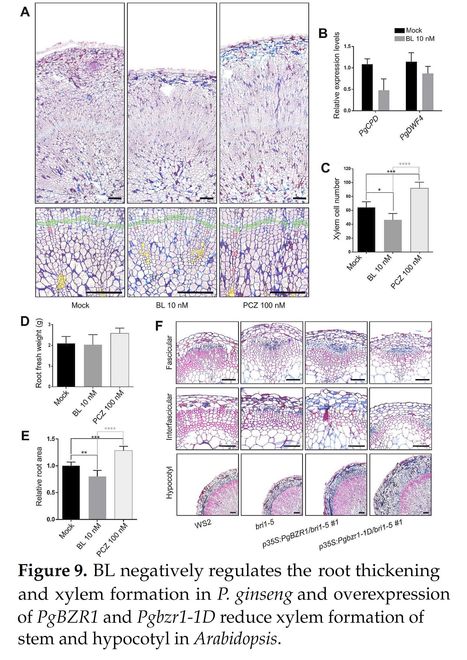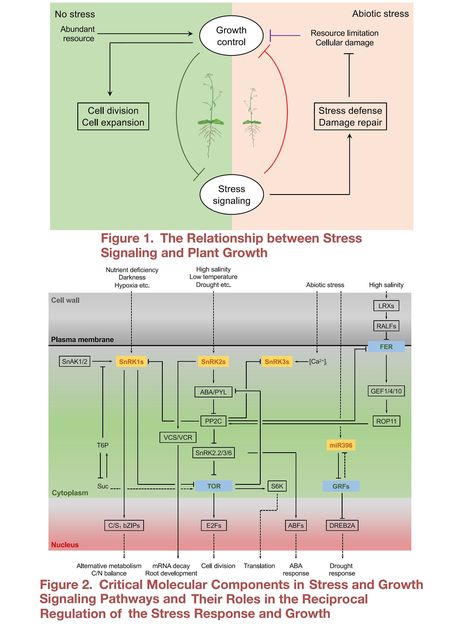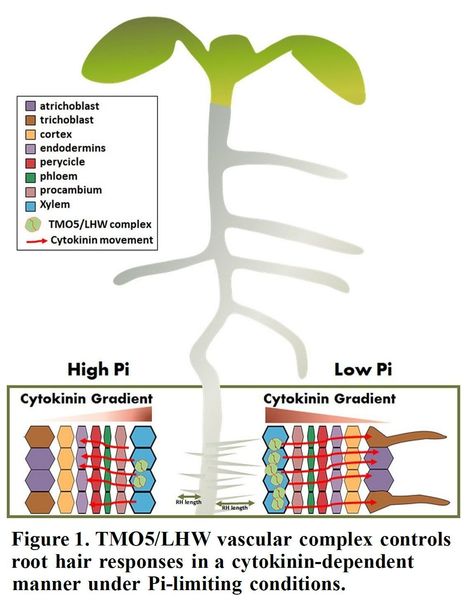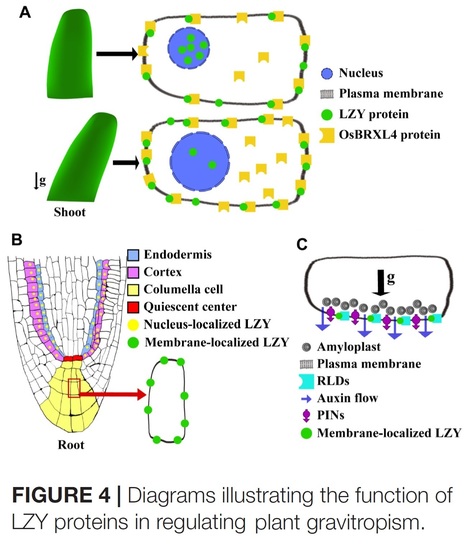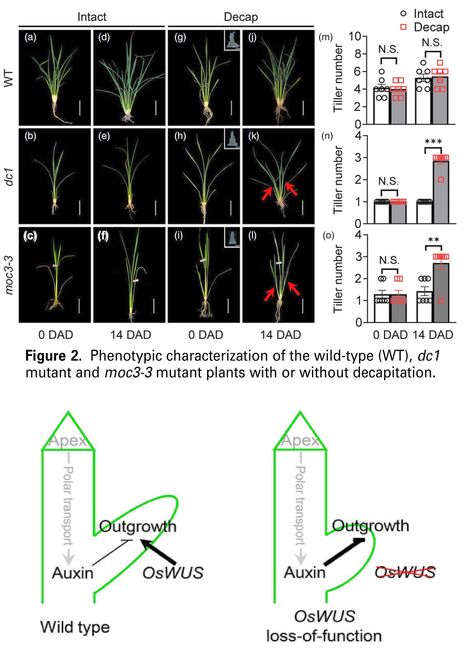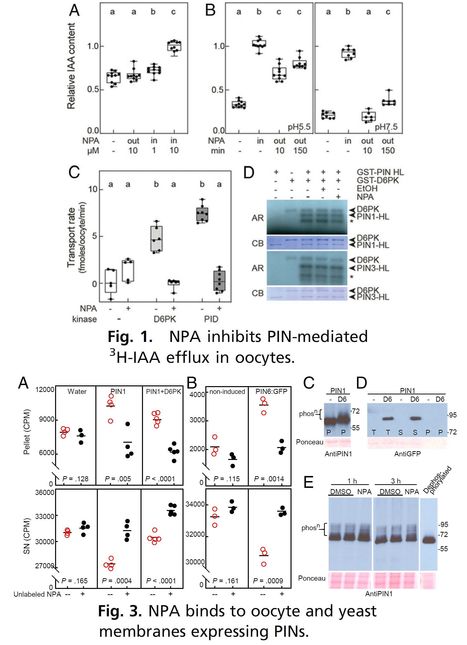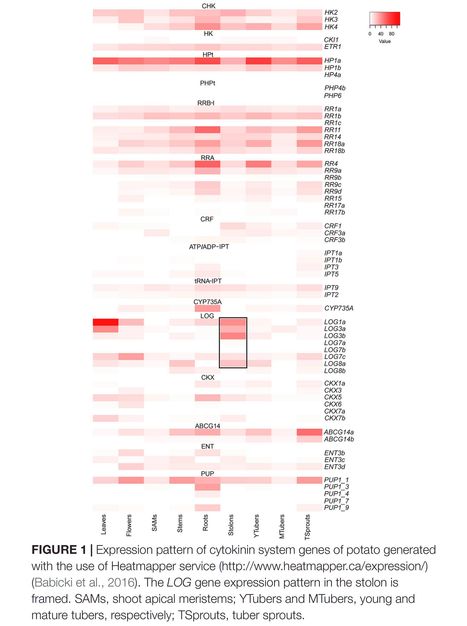 Your new post is loading...
 Your new post is loading...
Authors: Sachiko Tanaka, Kayo Hashimoto, Yuuki Kobayashi, Koji Yano, Taro Maeda, Hiromu Kameoka, Tatsuhiro Ezawa, Katsuharu Saito, Kohki Akiyama and Masayoshi Kawaguchi.
bioRxiv (2020)
Abstract: "Arbuscular mycorrhizal (AM) symbiosis is a mutually beneficial interaction between fungi and land plants and promotes global phosphate cycling in terrestrial ecosystems. AM fungi are recognised as obligate symbionts that require root colonisation to complete a life cycle involving the production of propagules, asexual spores. Recently it has been shown that Rhizophagus irregularis can produce infection-competent secondary spores asymbiotically by adding a fatty acid, palmitoleic acid. Further, asymbiotic growth can be supported using myristate as a carbon and energy source for their asymbiotic growth to increase fungal biomass. However, spore production and the ability of these spores to colonise host roots were still limited compared to co-culture of the fungus with plant roots. Here we show that a combination of two plant hormones, strigolactone and methyl jasmonate, induces production of a large number of infection-competent spores in asymbiotic cultures of Rhizophagus clarus HR1 in the presence of myristate and organic nitrogen. Inoculation of asymbiotically-generated spores promoted the growth of Welsh onions, as observed for spores produced by symbiotic culture system. Our findings provide a foundation for elucidation of hormonal control of the fungal life cycle and development of new inoculum production schemes."
Authors: Chi Zhang, Minta Chaiprasongsuk, Andre S. Chanderbali, Xinlu Chen, Jianyu Fu, Douglas E. Soltis and Feng Chen.
Plant Direct (2020)
Abstract: " Gibberellins (GAs) are a major class of plant hormones that regulates diverse developmental programs. Both acquiring abilities to synthesize GAs and evolving divergent GA receptors have been demonstrated to play critical roles in the evolution of land plants. In contrast, little is understood regarding the role of GA‐inactivating mechanisms in plant evolution. Here we report on the origin and evolution of GA methyltransferases (GAMTs), enzymes that deactivate GAs by converting bioactive GAs to inactive GA methylesters. Prior to this study, GAMT genes, which belong to the SABATH family, were known only from Arabidopsis. Through systematic searches for SABATH genes in the genomes of 260 sequenced land plants and phylogenetic analyses, we have identified a putative GAMT clade specific to seed plants. We have further demonstrated that both gymnosperm and angiosperm representatives of this clade encode active methyltransferases for GA methylation, indicating that they are functional orthologs of GAMT. In seven selected seed plants, GAMT genes were mainly expressed in flowers and/or seeds, indicating a conserved biological role in reproduction. GAMT genes are represented by a single copy in most species, if present, but multiple copies mainly produced by whole genome duplications have been retained in Brassicaceae. Surprisingly, more than 2/3 of the 248 flowering plants examined here lack GAMT genes, including all species of Poales (e.g., grasses), Fabales (legumes), and the large Superasterid clade of eudicots. With these observations, we discuss the significance of GAMT origination, functional conservation and diversification, and frequent loss during the evolution of flowering plants."
Authors: Cristina Martínez Andújar, Ascensión Martínez-Pérez, Alfonso Albacete Moreno, Purificación A. Martínez-Melgarejo, Ian Dodd, Andrew J. Thompson, Almudena Ferrández-Ayela, Jose Manuel Perez-Perez, Miriam Gifford and Francisco Pérez Alfocea.
Authorea (2020)
Abstract: "To determine whether root-supplied ABA alleviates saline stress, tomato (Solanum lycopersicum L. cv. Sugar Drop) was grafted onto two independent lines overexpressing the SlNCED1 (9-cis-epoxycarotenoid dioxygenase) gene (NCED OE) and wild type rootstocks. After 200 days of salinity irrigation (EC = 3.5 dS m-1), plants with NCED OE rootstocks had 30% higher fruit yield, but root biomass and lateral root development was reduced. Although NCED OE rootstocks upregulated ABA-signalling (AREB, ATHB12), ethylene-related (ACCs, ERFs), aquaporin (PIPs) and stress-related (TAS14, KIN, LEA) genes, downregulation of PYL ABA receptors and signalling components (WRKYs), ethylene synthesis (ACOs) and auxin responsive factors occurred. Elevated SlNCED1 expression enhanced ABA levels in reproductive tissue while ABA catabolites accumulated in leaf and xylem sap suggesting homeostatic mechanisms. NCED OE also reduced xylem cytokinin transport to the shoot and stimulated foliar 2-isopentenyl adenine (iP) accumulation and phloem transport. Moreover, increased xylem gibberellin GA3 levels in growing fruit trusses was associated with enhanced reproductive growth. Improved photosynthesis without changes in stomatal conductance was consistent with hormone-mediated alteration of leaf growth and mesophyll structure, which combined with lower assimilate requirement in the roots and systemic changes in hormone balances could explain enhanced vigour, reproductive growth and yield under saline stress."
Authors: Dawei Zhang, Wenrong Tan, Feng Yang, Qing Han, Xingguang Deng, Hongqing Guo, Baohui Liu, Yanhai Yin and Honghui Lin.
Developmental Cell (2021)
Editor's view: BR signaling is known to inhibit photomorphogenesis, including chloroplast development, but the mechanism underlying this is not well known. Zhang et al. identify a BIN2-GLK1 signaling module that integrates BR and light to precisely fine-tune chloroplast development in response to light conditions.
Highlights: • BR signaling inhibits chloroplast development • BIN2 interacts with and phosphorylates GLKs in nuclei • Phosphorylation by BIN2 promotes the stability and transcriptional activity of GLK1 • GLK1 phosphorylation during light conditions positively regulates cotyledon greening
Abstract: "Arabidopsis GLYCOGEN SYNTHASE KINASE 3 (GSK3)-like kinases play various roles in plant development, including chloroplast development, but the underlying molecular mechanism is not well defined. Here, we demonstrate that transcription factors GLK1 and GLK2 interact with and are phosphorylated by the BRASSINOSTEROID insensitive2 (BIN2). The loss-of-function mutant of BIN2 and its homologs, bin2-3 bil1 bil2, displays abnormal chloroplast development, whereas the gain-of-function mutant, bin2-1, exhibits insensitivity to BR-induced de-greening and reduced numbers of thylakoids per granum, suggesting that BIN2 positively regulates chloroplast development. Furthermore, BIN2 phosphorylates GLK1 at T175, T238, T248, and T256, and mutations of these phosphorylation sites alter GLK1 protein stability and DNA binding and impair plant responses to BRs/darkness. On the other hand, BRs and darkness repress the BIN2-GLK module to enhance BR/dark-mediated de-greening and impair the formation of the photosynthetic apparatus. Our results thus provide a mechanism by which BRs modulate photomorphogenesis and chloroplast development."
Authors: Qian‐Qian Li, Zhan Zhang, Ya‐Ling Wang, Li‐Yuan Zhong, Zhen‐Fei Chao, Yi‐Qun Gao, Mei‐Ling Han, Lin Xu and Dai‐Yin Chao.
The Plant Journal (2021)
Abstract: "Adventitious roots (ARs) are an important root type for plants and display a high phenotypic plasticity in response to different environmental stimuli. Previous studies found that dark‐light transition can trigger AR formation from the hypocotyl of etiolated Arabidopsis thaliana, which was used as model for identification of regulators of AR biogenesis. However, the central regulatory machinery for darkness‐induced hypocotyl AR (HAR) remains elusive. Here, we report that photoreceptors suppress HAR biogenesis through regulating the molecular module essential for lateral roots. We found that hypocotyls embedded in soil or in continuous darkness are able to develop HARs, wherein photoreceptors act as negative regulators. Distinct from wound‐induced ARs that require WOX11 and WOX12, darkness‐induced HARs are fully dependent on ARF7, ARF19, WOX5/7 and LBD16. Further studies established that PHYB interacts with IAA14, ARF7 and ARF9. The interactions stabilize IAA14 and inhibit the transcriptional activities of ARF7 and ARF19 and thus suppress biogenesis of darkness‐induced HARs. This finding not only revealed the central machinery controlling HAR biogenesis but also illustrated that AR formation could be initiated by multiple pathways."
Author: Peter Hedden.
Plant and Cell Physiology (2020)
Abstract: "Gibberellins are produced by all vascular plants and several fungal and bacterial species that associate with plants as pathogens or symbionts. In the 60 years since the first experiments on the biosynthesis of gibberellic acid in the fungus Fusarium fujikuroi, research on gibberellin biosynthesis has advanced to provide detailed information on the pathways, biosynthetic enzymes and their genes in all three kingdoms, in which the production of the hormones evolved independently. Gibberellins function as hormones in plants, affecting growth and differentiation in organs in which their concentration is very tightly regulated. Current research in plants is focused particularly on the regulation of gibberellin biosynthesis and inactivation by developmental and environmental cues, and there is now considerable information on the molecular mechanisms involved in these processes. There have also been recent advances in understanding gibberellin transport and distribution and their relevance to plant development. This review describes our current understanding of gibberellin metabolism and its regulation, highlighting the more recent advances in this field."
Authors: Hyeona Hwang, Hwa-Yong Lee, Hojin Ryu and Hyunwoo Cho.
International Journal of Molecular Sciences (2020)
Abstract: "Brassinosteroids (BRs) play crucial roles in the physiology and development of plants. In the model plant Arabidopsis, BR signaling is initiated at the level of membrane receptors, BRASSINOSTEROIDS INSENSITIVE 1 (BRI1) and BRI1-ASSOCIATED RECEPTOR KINASE 1 (BAK1) complex, thus activating the transcription factors (TFs) BRASSINAZOLE RESISTANT 1/BRI1-EMS-SUPPRESSOR 1 (BZR1/BES1) to coordinate BR responsive genes. BRASSINOSTEROIDS INSENSITIVE 2 (BIN2), glycogen synthase kinase 3 (GSK3) like-kinase, negatively regulates BZR1/BES1 transcriptional activity through phosphorylation-dependent cytosolic retention and shuttling. However, it is still unknown whether this mechanism is conserved in Panax ginseng C. A. Mayer, a member of the Araliaceae family, which is a shade-tolerant perennial root crop. Despite its pharmacological and agricultural importance, the role of BR signaling in the development of P. ginseng and characterization of BR signaling components are still elusive. In this study, by utilizing the Arabidopsis bri1 mutant, we found that ectopic expression of the gain of function form of PgBZR1 (Pgbzr1-1D) restores BR deficiency. In detail, ectopic expression of Pgbzr1-1D rescues dwarfism, defects of floral organ development, and hypocotyl elongation of bri1-5, implying the functional conservation of PgBZR1 in P. ginseng. Interestingly, brassinolide (BL) and BRs biosynthesis inhibitor treatment in two-year-old P. ginseng storage root interferes with and promotes, respectively, secondary growth in terms of xylem formation. Altogether, our results provide new insight into the functional conservation and potential diversification of BR signaling and response in P. ginseng."
Authors: Jianyang Liu, Yanning Wang and Youfa Cheng.
The Plant Journal (2020)
Abstract: "The highly conserved endosomal sorting complex required for transport (ESCRT) pathway plays critical roles in endosomal sorting of ubiquitinated plasma membrane proteins for degradation. However, the functions of many components of the ESCRT machinery in plants remain unsolved. Here we show that the ESCRT‐I subunits VPS28A and VPS28B are functionally redundant and required for embryonic development in Arabidopsis. We conducted a screen for genetic enhancers of pid, which is defective in auxin signaling and transport. We isolated a no‐‐cotyledon in pid 104 (ncp104) mutant, which failed to develop cotyledons in a pid background. We discovered that ncp104 was a unique recessive gain‐of‐function allele of vps28a. VPS28A and VPS28B were expressed during embryogenesis and the proteins were localized to the trans‐Golgi network/early endosome and post‐Golgi/endosomal compartments, consistent with their functions in endosomal sorting and embryogenesis. The single vps28a and vps28b loss‐of‐function mutants did not display obvious developmental defects, but their double mutants showed abnormal cell division patterns and were arrested at the globular embryo stage. The vps28a vps28b double mutants showed altered auxin responses, disrupted PIN1‐GFP expression patterns, and abnormal PIN1‐GFP accumulation in small aberrant vacuoles. The ncp104 mutation may cause the VPS28A protein to become unstable and/or toxic. Taken together, our findings demonstrate that the ESCRT‐I components VPS28A and VPS28B redundantly play essential roles in vacuole formation, endosomal sorting of plasma membrane proteins, and auxin‐mediated plant development."
Authors: Damiano Martignago, Beata Siemiatkowska, Alessandra Lombardi and Lucio Conti.
International Journal of Molecular Sciences (2020)
Abstract: "Plants can react to drought stress by anticipating flowering, an adaptive strategy for plant survival in dry climates known as drought escape (DE). In Arabidopsis, the study of DE brought to surface the involvement of abscisic acid (ABA) in controlling the floral transition. A central question concerns how and in what spatial context can ABA signals affect the floral network. In the leaf, ABA signaling affects flowering genes responsible for the production of the main florigen FLOWERING LOCUS T (FT). At the shoot apex, FD and FD-like transcription factors interact with FT and FT-like proteins to regulate ABA responses. This knowledge will help separate general and specific roles of ABA signaling with potential benefits to both biology and agriculture."
Authors: Heng Zhang, Yang Zhao and Jian-Kang Zhu.
Developmental Cell (2020)
Abstract: "Defense against stress and active suppression of growth are two complementary strategies by which plants respond to adverse environments. Although beneficial for plant survival, active growth inhibition is often undesirable for crop productivity. Compared with the knowledge on how plants defend against stress-caused cellular impairment, much less is known about how stress signaling regulates plant growth and vice versa. Here, we review recent progress in this area and discuss recent studies suggesting that reciprocal regulation between stress-response and growth-control pathways occurs at multiple levels. Understanding this regulatory network will be critical for resetting the balance between stress resistance and growth in order to engineer stress-resistant and high-yielding crops."
Authors: Bauyrzhan Smailov, Sanzhar Alybayev, Izat Smekenov, Aibek Mursalimov, Murat Saparbaev, Dos Sarbassov and Amangeldy Bissenbaev.
Frontiers in Cell and Developmental Biology (2020)
Abstract: "Germination is a process of seed sprouting that facilitates embryo growth. The breakdown of reserved starch in the endosperm into simple sugars is essential for seed germination and subsequent seedling growth. At the early stage of germination, gibberellic acid (GA) activates transcription factor GAMYB to promote de novo synthesis of isoforms of α-amylase in the aleurone layer and scutellar epithelium of the embryo. Here, we demonstrate that wheat germination is regulated by plant target of rapamycin (TOR) signaling. TOR is a central component of the essential-nutrient–dependent pathway controlling cell growth in all eukaryotes. It is known that rapamycin, a highly specific allosteric inhibitor of TOR, is effective in yeast and animal cells but ineffective in most of higher plants likely owing to structural differences in ubiquitous rapamycin receptor FKBP12. The action of rapamycin on wheat growth has not been studied. Our data show that rapamycin inhibits germination of wheat seeds and of their isolated embryos in a dose-dependent manner. The involvement of Triticum aestivum TOR (TaTOR) in wheat germination was consistent with the suppression of wheat embryo growth by specific inhibitors of the TOR kinase: pp242 or torin1. Rapamycin or torin1 interfered with GA function in germination because of a potent inhibitory effect on α-amylase and GAMYB gene expression. The TOR inhibitors selectively targeted the GA-dependent gene expression, whereas expression of the abscisic acid-dependent ABI5 gene was not affected by either rapamycin or torin1. To determine whether the TaTOR kinase activation takes place during wheat germination, we examined phosphorylation of a ribosomal protein, T. aestivum S6 kinase 1 (TaS6K1; a substrate of TOR). The phosphorylation of serine 467 (S467) in a hydrophobic motif on TaS6K1 was induced in a process of germination triggered by GA. Moreover, the germination-induced phosphorylation of TaS6K1 on S467 was dependent on TaTOR and was inhibited by rapamycin or torin1. Besides, a gibberellin biosynthesis inhibitor (paclobutrazol; PBZ) blocked not only α-amylase gene expression but also TaS6K1 phosphorylation in wheat embryos. Thus, a hormonal action of GA turns on the synthesis of α-amylase in wheat germination via activation of the TaTOR–S6K1 signaling pathway."
Author: Maida Romera-Branchat.
Molecular Plant (2021)
Excerpts: "Phosphorus (Pi) is a macronutrient essential for crucial plant biological processes including photosynthesis. To cope with the limited availability of Pi in the soil, plants have developed strategies such as increased hair root density to acquire this immobile nutrient. However, the precise molecular mechanisms involved in such strategies have not been fully elucidated. The production of bioactive cytokinin (CK) in the xylem was previously shown to be transcriptionally regulated by the bHLH transcription factors, TARGET OF MONOPTERS 5/LONESOME HIGHWAY (TMO5/LHW) dimeric complex. Although the movement of CK from the xylem to neighboring tissues such as the procambium is known to induce cell proliferation (De Rybel et al., 2014), how CK controls tissue growth beyond the vascular tissue was unknown."
"Altogether, this study indicates that the TMO5/LHW vascular complex functions cell non-autonomously to increase root hair density, and that CK is the mobile long-distance signal that depends on TMO5 to boost root hair growth under limiting Pi conditions (Figure 1). Understanding the genetic and molecular mechanisms of how plants respond to low Pi will guide the development of new cultivation strategies to avoid the overuse of fertilizers containing Pi."
Authors: Zhicheng Jiao, Huan Du, Shu Chen, Wei Huang and Liangfa Ge.
Frontiers in Plant Science (2021)
Abstract: "Adapting to the omnipresent gravitational field was a fundamental basis driving the flourishing of terrestrial plants on the Earth. Plants have evolved a remarkable capability that not only allows them to live and develop within the Earth’s gravity field, but it also enables them to use the gravity vector to guide the growth of roots and shoots, in a process known as gravitropism. Triggered by gravistimulation, plant gravitropism is a highly complex, multistep process that requires many organelles and players to function in an intricate coordinated way. Although this process has been studied for several 100 years, much remains unclear, particularly the early events that trigger the relocation of the auxin efflux carrier PIN-FORMED (PIN) proteins, which presumably leads to the asymmetrical redistribution of auxin. In the past decade, the LAZY gene family has been identified as a crucial player that ensures the proper redistribution of auxin and a normal tropic response for both roots and shoots upon gravistimulation. LAZY proteins appear to be participating in the early steps of gravity signaling, as the mutation of LAZY genes consistently leads to altered auxin redistribution in multiple plant species. The identification and characterization of the LAZY gene family have significantly advanced our understanding of plant gravitropism, and opened new frontiers of investigation into the novel molecular details of the early events of gravitropism. Here we review current knowledge of the LAZY gene family and the mechanism modulated by LAZY proteins for controlling both roots and shoots gravitropism. We also discuss the evolutionary significance and conservation of the LAZY gene family in plants."
|
Authors: Fernanda Garrido-Vargas, Tamara Godoy, Ricardo Tejos and José Antonio O’Brien.
International Journal of Molecular Sciences (2020)
Abstract: "Soil salinity is a key problem for crop production worldwide. High salt concentration in soil negatively modulates plant growth and development. In roots, salinity affects the growth and development of both primary and lateral roots. The phytohormone auxin regulates various developmental processes during the plant’s life cycle, including several aspects of root architecture. Auxin signaling involves the perception by specialized receptors which module several regulatory pathways. Despite their redundancy, previous studies have shown that their functions can also be context-specific depending on tissue, developmental or environmental cues. Here we show that the over-expression of Auxin Signaling F-Box 3 receptor results in an increased resistance to salinity in terms of root architecture and germination. We also studied possible downstream signaling components to further characterize the role of auxin in response to salt stress. We identify the transcription factor SZF1 as a key component in auxin-dependent salt stress response through the regulation of NAC4. These results give lights of an auxin-dependent mechanism that leads to the modulation of root system architecture in response to salt identifying a hormonal cascade important for stress response."
Authors: H. Tucker Hallmark and Aaron M. Rashotte.
Plant Direct (2020)
Abstract: "Cytokinins (CKs) are well‐known as a class of phytohormones capable of delaying senescence in detached leaves. However, CKs are often treated as a monolithic group of compounds even though dozens of CK species are present in plants with varied degrees of reported biological activity. One specific type of CK, isopentenyladenine base (iP), has been demonstrated as having roles in delaying leaf senescence, inhibition of root growth, and promoting shoot regeneration. However, its N‐glucosides isopentenyladenine‐7‐ and ‐9‐glucoside (iP7G, iP9G) have remained understudied and thought of as inactive cytokinins for several decades, despite their relatively high concentrations in plants such as the model species Arabidopsis thaliana. Here we show that iP and one of its glucosides, iP9G, are capable of delaying senescence in leaves, though the glucosides having little to no activity in other bioassays. Additionally, we performed the first transcriptomic study of iP‐delayed cotyledon senescence which shows that iP is capable of upregulating photosynthetic genes and downregulating catabolic genes in detached cotyledons. Transcriptomic analysis also shows iP9G has limited effects on gene expression, but that the few affected genes are CK‐related and are similar to those seen from iP effects during senescence as seen for the type‐A response regulator ARR6. These findings suggest that iP9G functions as an active CK during senescence."
Authors: Zhiyuan Bian, Huanhuan Gao and Chongying Wang.
International Journal of Molecular Sciences (2020)
Abstract: "The NAC (NAM, ATAF1/2, and CUC2) family of proteins is one of the largest plant-specific transcription factor (TF) families and its members play varied roles in plant growth, development, and stress responses. In recent years, NAC TFs have been demonstrated to participate in crop-pathogen interactions, as positive or negative regulators of the downstream defense-related genes. NAC TFs link signaling pathways between plant hormones, including salicylic acid (SA), jasmonic acid (JA), ethylene (ET), and abscisic acid (ABA), or other signals, such as reactive oxygen species (ROS), to regulate the resistance against pathogens. Remarkably, NAC TFs can also contribute to hypersensitive response and stomatal immunity or can be hijacked as virulence targets of pathogen effectors. Here, we review recent progress in understanding the structure, biological functions and signaling networks of NAC TFs in response to pathogens in several main food crops, such as rice, wheat, barley, and tomato, and explore the directions needed to further elucidate the function and mechanisms of these key signaling molecules."
Authors: Galina Smolikova, Tatiana Leonova, Natalia Vashurina, Andrej Frolov and Sergei Medvedev.
International Journal of Molecular Sciences (2020)
Abstract: "Desiccation tolerance appeared as the key adaptation feature of photoautotrophic organisms for survival in terrestrial habitats. During the further evolution, vascular plants developed complex anatomy structures and molecular mechanisms to maintain the hydrated state of cell environment and sustain dehydration. However, the role of the genes encoding the mechanisms behind this adaptive feature of terrestrial plants changed with their evolution. Thus, in higher vascular plants it is restricted to protection of spores, seeds and pollen from dehydration, whereas the mature vegetative stages became sensitive to desiccation. During maturation, orthodox seeds lose up to 95% of water and successfully enter dormancy. This feature allows seeds maintaining their viability even under strongly fluctuating environmental conditions. The mechanisms behind the desiccation tolerance are activated at the late seed maturation stage and are associated with the accumulation of late embryogenesis abundant (LEA) proteins, small heat shock proteins (sHSP), non-reducing oligosaccharides, and antioxidants of different chemical nature. The main regulators of maturation and desiccation tolerance are abscisic acid and protein DOG1, which control the network of transcription factors, represented by LEC1, LEC2, FUS3, ABI3, ABI5, AGL67, PLATZ1, PLATZ2. This network is complemented by epigenetic regulation of gene expression via methylation of DNA, post-translational modifications of histones and chromatin remodeling. These fine regulatory mechanisms allow orthodox seeds maintaining desiccation tolerance during the whole period of germination up to the stage of radicle protrusion. This time point, in which seeds lose desiccation tolerance, is critical for the whole process of seed development."
Authors: Hideki Yoshida, Masatoshi Nakajima and Makoto Matsuoka
Plant and Cell Physiology (2020)
Excerpts: "More than 100 years ago, a Japanese plant pathologist reported that the ‘foolish seedling disease’ of rice was caused by fungal infection (Hori 1898); this was the first report dealing with gibberellin (GA). Because this disease induced severe problems for rice cultivation, Japanese scientists intensively studied its cause. They eventually found that such abnormal growth was caused by a chemical called GA, after its fungal source Gibberella fujikuroi (Yabuta 1935)."
"Five of the articles in this special issue focus on GA metabolism. With over a half-century of research, GA metabolic pathways in plants, fungi and bacteria are now thought to be well understood."
"This issue also contains three review papers focusing on more specific evolutionary features of GA metabolism."
"This issue also contains three review papers to describe and discuss the mechanisms underlying the regulation of GA action in terms of epigenetic, posttranscriptional and posttranslational regulation."
Authors: Yunhua Xiao, Junwen Zhang, Guiyuan Yu, Xuedan Lu, Wentao Mei, Huabing Deng, Guilian Zhang, Guihua Chen, Chengcai Chu, Hongning Tong and Wenbang Tang.
Frontiers in Plant Science (2020)
Abstract: "Cytokinins (CKs) are a class of phytohormones playing essential roles in various biological processes. However, the mechanisms underlying CK transport as well as its function in plant growth and development are far from being fully elucidated. Here, we characterize the function of PURINE PERMEASE1 (OsPUP1) in rice (Oryza sativa L.). OsPUP1 was predominantly expressed in the root, particularly in vascular cells, and CK treatment can induce its expression. Subcellular localization analysis showed that OsPUP1 was predominantly localized to the endoplasmic reticulum (ER). Overexpression of OsPUP1 resulted in growth defect of various aerial tissues, including decreased leaf length, plant height, grain weight, panicle length, and grain number. Hormone profiling revealed that the CK content was decreased in the shoot of OsPUP1-overexpressing seedling, but increased in the root, compared with the wild type. The CK content in the panicle was also decreased. Quantitative reverse transcription-PCR (qRT-PCR) analysis using several CK type-A response regulators (OsRRs) as the marker genes suggested that the CK response in the shoot of OsPUP1-overexpressing seedling is decreased compared to the wild type when CKs are applied to the root. Genetic analysis revealed that BG3/OsPUP4, a putative plasma membrane-localized CK transporter, overcomes the function of OsPUP1. We hypothesize that OsPUP1 might be involved in importing CKs into ER to unload CKs from the vascular tissues be involved in importing CKs into ER to unload CKs from the vascular tissues by cell-to-cell transport."
Authors: Tianyu Xia, Hongqi Chen, Sujun Dong, Zeyang Ma, Haibo Ren, Xudong Zhu, Xiaohua Fang and Fan Chen.
The Plant Journal (2020)
Abstract: "Two branching strategies are exhibited in crops: enhanced apical dominance, as in maize; or weak apical dominance, as in rice. However, the underlying mechanism of weak apical dominance remains elusive. OsWUS, an ortholog of Arabidopsis WUSCHEL (WUS) in rice, is required for tiller development. In this study, we identified and functionally characterized a low‐tillering mutant decreased culm number 1 (dc1) that resulted from loss‐of‐function of OsWUS. The dc1 tiller buds are viable but repressed by the main culm apex, leading to stronger apical dominance than that of the wild‐type (WT). Auxin response is enhanced in the dc1 mutant, and knocking out the auxin action‐associated gene ABERRANT SPIKELET AND PANICLE 1 (ASP1) de‐repressed growth of the tiller buds in the dc1 mutant, suggesting that OsWUS and ASP1 are both involved in outgrowth of the rice tiller bud. Decapitation triggers higher contents of cytokinins in the shoot base of the dc1 mutant compared with those in the WT, and exogenous application of cytokinin is not sufficient for sustained growth of the dc1 tiller bud. Transcriptome analysis indicated that expression levels of transcription factors putatively bound by ORYZA SATIVA HOMEOBOX 1 (OSH1) are changed in response to decapitation and display a greater fold change in the dc1 mutant than that in the WT. Collectively, these findings reveal an important role of OsWUS in tiller bud growth by influencing apical dominance, and provide the basis for an improved understanding of tiller bud development in rice."
Authors: Lindy Abas, Martina Kolb, Johannes Stadlmann, Dorina P. Janacek, Kristina Lukic, Claus Schwechheimer, Leonid A. Sazanov, Lukas Mach, Jiří Friml, and Ulrich Z. Hammes.
PNAS (2021)
Significance: The plant hormone auxin regulates many aspects of plant life and has the unique ability to flow throughout the plant in defined directions, as observed by Darwin over a century ago. The chemical NPA inhibits this directional flow, thereby severely affecting plant growth. In studying the specific effects of NPA, researchers have also uncovered general principles underlying plant development. Exactly how NPA inhibits directional auxin flow is unclear. NPA interacts with proteins that can transport auxin, such as ABCB transporters, and we show here that NPA also associates with and inhibits the major transporters that specialize in directional auxin flow—PINs. This explanation of NPA action will guide future research and may help reveal how PINs perform auxin transport.
Abstract: "N-1-naphthylphthalamic acid (NPA) is a key inhibitor of directional (polar) transport of the hormone auxin in plants. For decades, it has been a pivotal tool in elucidating the unique polar auxin transport-based processes underlying plant growth and development. Its exact mode of action has long been sought after and is still being debated, with prevailing mechanistic schemes describing only indirect connections between NPA and the main transporters responsible for directional transport, namely PIN auxin exporters. Here we present data supporting a model in which NPA associates with PINs in a more direct manner than hitherto postulated. We show that NPA inhibits PIN activity in a heterologous oocyte system and that expression of NPA-sensitive PINs in plant, yeast, and oocyte membranes leads to specific saturable NPA binding. We thus propose that PINs are a bona fide NPA target. This offers a straightforward molecular basis for NPA inhibition of PIN-dependent auxin transport and a logical parsimonious explanation for the known physiological effects of NPA on plant growth, as well as an alternative hypothesis to interpret past and future results. We also introduce PIN dimerization and describe an effect of NPA on this, suggesting that NPA binding could be exploited to gain insights into structural aspects of PINs related to their transport mechanism."
Authors: Junzhe Wang, Xiaolong Guo, Qiang Xiao, Jianchu Zhu, Alice Y. Cheung, Li Yuan, Elizabeth Vierling and Shengbao Xu.
New Phytologist (2021)
Abstract: "The nucellus tissue in flowering plants provides nutrition for the development of the female gametophyte (FG) and young embryo. The nucellus degenerates as the FG develops, but the mechanism controlling the coupled process of nucellar degeneration and FG expansion remains largely unknown. The degeneration process of the nucellus and spatiotemporal auxin distribution in the developing ovule before fertilization were investigated in Arabidopsis thaliana. Nucellar degeneration before fertilization occurs through vacuolar cell death and in a ordered degeneration fashion. This sequential nucellar degeneration is controlled by the signalling molecule auxin. Auxin efflux plays the core role in precisely controlling the spatiotemporal pattern of auxin distribution in the nucellus surrounding the FG. The auxin efflux carrier PIN1 transports maternal auxin into the nucellus while PIN3/PIN4/PIN7 further delivers auxin to degenerating nucellar cells and concurrently controls FG central vacuole expansion. Notably, auxin level and auxin efflux are controlled by the maternal tissues, acting as a key communication from maternal to filial tissue."
Authors: Sergey N. Lomin, Yulia A. Myakushina, Oksana O. Kolachevskaya, Irina A. Getman, Ekaterina M. Savelieva, Dmitry V. Arkhipov, Svetlana V. Deigraf and Georgy A. Romanov.
Frontiers in Plant Science (2020)
Abstract: "Cytokinins (CKs) were earlier shown to promote potato tuberization. Our study aimed to identify and characterize CK-related genes which constitute CK regulatory system in the core potato (Solanum tuberosum) genome. For that, CK-related genes were retrieved from the sequenced genome of the S. tuberosum doubled monoploid (DM) Phureja group, classified and compared with Arabidopsis orthologs. Analysis of selected gene expression was performed with a transcriptome database for the S. tuberosum heterozygous diploid line RH89-039-16. Genes responsible for CK signaling, biosynthesis, transport, and metabolism were categorized in an organ-specific fashion. According to this database, CK receptors StHK2/3 predominate in leaves and flowers, StHK4 in roots. Among phosphotransmitters, StHP1a expression largely predominates. Surprisingly, two pseudo-phosphotransmitters intended to suppress CK effects are hardly expressed in studied organs. Among B-type RR genes, StRR1b, StRR11, and StRR18a are actively expressed, with StRR1b expressing most uniformly in all organs and StRR11 exhibiting the highest expression in roots. By cluster analysis four types of prevailing CK-signaling chains were identified in (1) leaves and flowers, StHK2/3→StHP1a→StRR1b/+; (2) shoot apical meristems, stolons, and mature tubers, StHK2/4→StHP1a→StRR1b/+; (3) stems and young tubers, StHK2/4→StHP1a→StRR1b/11/18a; and (4) roots and tuber sprouts, StHK4→StHP1a→StRR11/18a. CK synthesis genes StIPT3/5 and StCYP735 are expressed mainly in roots followed by tuber sprouts, but rather weakly in stolons and tubers. By contrast, CK-activation genes StLOGs are active in stolons, and StLOG3b expression is even stolon-confined. Apparently, the main CK effects on tuber initiation are realized via activity of StLOG1/3a/3b/7c/8a genes in stolons. Current advances and future directions in potato research are discussed."
Authors: Hang Su, Tian Wang, Chuanfeng Ju, Jinping Deng, Tianqi Zhang, Mengjiao Li, Hui Tian and Cun Wang.
Journal of Integrative Plant Biology (2021)
Abstract: "Nitrogen (N) is a limiting nutrient for plant growth and productivity. The phytohormone abscisic acid (ABA) has been suggested to play a vital role in nitrate uptake in fluctuating N environments. However, the molecular mechanisms underlying the involvement of ABA in N deficiency responses are largely unknown. In this study, we demonstrated that ABA signaling components, particularly the three subclass III SUCROSE NON‐FERMENTING1 (SNF1)‐RELATED PROTEIN KINASE 2S (SnRK2) proteins, function in root foraging and uptake of nitrate under N deficiency in Arabidopsis thaliana. The snrk2.2snrk2.3snrk2.6 triple mutant grew a longer primary root and had a higher rate of nitrate influx and accumulation compared with wild‐type plants under nitrate deficiency. Strikingly, SnRK2.2/2.3/2.6 proteins interacted with and phosphorylated the nitrate transceptor NITRATE TRANSPORTER1.1 (NRT1.1) in vitro and in vivo. The phosphorylation of NRT1.1 by SnRK2s resulted in a significant decrease of nitrate uptake and impairment of root growth. Moreover, we identified NRT1.1Ser585 as a previously unknown functional site: the phosphomimetic NRT1.1S585D was impaired in both low‐ and high‐affinity transport activities. Taken together, our findings provide new insight into how plants fine‐tune growth via ABA signaling under N deficiency."
Authors: Zenglin Zhang, Mengmeng Xu and Yongfeng Guo.
Frontiers in Plant Science (2020)
Abstract: "Leaf senescence is regulated by a large number of internal and environmental factors. Here, we report that AtUSR1 (U-box Senescence Related 1) which encodes a plant Ring/U-box protein, is involved in age-dependent and dark-induced leaf senescence in Arabidopsis. Expression of AtUSR1 gene in leaves was up-regulated in darkness and during aging. Plants of usr1, an AtUSR1 gene knock-down mutant, showed a significant delay in age-dependent and dark-induced leaf senescence and the delayed senescence phenotype was rescued when the AtUSR1 gene was transferred back to the mutant plants. Meanwhile, overexpression of AtUSR1 caused accelerated leaf senescence. Furthermore, the role of AtUSR1 in regulating leaf senescence is related to MYC2-mediuated jasmonic acid (JA) signaling pathway. MeJA treatments promoted the accumulation of AtUSR1 transcripts and this expression activation was dependent on the function of MYC2, a key transcription factor in JA signaling. Dual-luciferase assay results indicated that MYC2 promoted the expression of AtUSR1. Overexpression of AtUSR1 in myc2 mutant plants showed precocious senescence, while myc2 mutation alone caused a delay in leaf senescence, suggesting that AtUSR1 functions downstream to MYC2 in the JA signaling pathway in promoting leaf senescence."
|



 Your new post is loading...
Your new post is loading...








